Dika
Forum Replies Created
Viewing 13 posts - 1 through 13 (of 13 total)
-
DikaParticipantI followed Melissa's advice and walked on the shore in the early morning at low tide. I was especially happy to find an abundance of Western Snowy Plovers on the beach at Coal Oil Point (just west of UCSB). These birds are listed as threatened since 1993 but they nest at this protected location each year. Many signs encourage visitors to keep a distance from the nesting area which is roped off. However the rest of the beach is open to walkers and surfers. I was especially pleased that a pair of these very cute young birds showed no fear of me as I watched them. Though I did not get down on my belly on the wet sand I squatted for quite a long time. Neither bird moved until I got up and left. My shutter speed was 1/800, my aperture F4 and ISO 160. My lens was at 600mm. When I look at these photos greatly magnified I can see every individual feather. Editing was in Photoshop only - haze removal and Levels adjustment. Only minor cropping.

 The rear bird is slightly out of focus due to narrow range of focus (F4).
The rear bird is slightly out of focus due to narrow range of focus (F4).
 in reply to: Practice Understanding Birds for Better Photos #724975
in reply to: Practice Understanding Birds for Better Photos #724975 -
DikaParticipantThis morning I drove to the Carpinteria Salt Marsh Nature Reserve to see what birds were there. A lot of Cliff Swallows darted so fast it was nearly impossible to focus on one in flight. I had better luck with a distant White-tailed Kite that I was able to get the camera on. My focus in this class has been on birds in flight so I caught a few attractive flight photos of this beautiful bird.


 Obviously I had to crop a good amount. I was shooting F4, 1/1250 at ISO 100. In burst mode this camera gets as many as 20 shots per second. What I noticed was that in every other photo the bird's wings were up and the other they were down. In the 3rd one the bird was flying directly toward me. The advantage of photographing a kite is that once you have the camera on the bird it pretty much stays in the same location in the sky. in reply to: Practice Capturing Birds in Flight #724713
Obviously I had to crop a good amount. I was shooting F4, 1/1250 at ISO 100. In burst mode this camera gets as many as 20 shots per second. What I noticed was that in every other photo the bird's wings were up and the other they were down. In the 3rd one the bird was flying directly toward me. The advantage of photographing a kite is that once you have the camera on the bird it pretty much stays in the same location in the sky. in reply to: Practice Capturing Birds in Flight #724713 -
DikaParticipant1. Deciding which software tools to use for editing my images, both RAW and jpeg. I use both a Canon 7D mark 2 and a Sony RX10 Mark 4 for my bird photography. When shooting RAW which I do only about 1/2 the time I at first used the digital image processing tools provided by each camera maker. I took the trouble to download and learn Sony's Imaging Edge desktop to view and manipulate the raw image (.ARW) and then export to Photoshop. It seemed worthwhile to have 1 tool that worked for both cameras so I purchased the newest version of Adobe Photoshop Elements, which includes Camera Raw. I don't think it is as powerful as the tools specific to each camera model, and it appears to be fairly similar to Lightroom. One of the problems I've encountered is in photographing white birds against water. When shooting in manual mode with auto ISO the whites are often totally burned out, so I will use exposure compensation to underexpose by at least 1 full stop. Then in photoshop I can select the offending bird (quick select) and use a brightness/contrast layer mask over just that area to bring in detail in that previously all white area. I don't find any of the raw processing tools that allow you to select just one area of the image, and Photoshop is very good at that. 2. Organizing the images on my computer. As soon as I get home from a photo shoot I view all images by projecting to the TV screen, which allows me to cull at least 75% of them on the card. I did not want to use Organizer to define a system of storage on my computer (which is a Dell laptop). Since I generally bird in a few hotspots in this area I organize by folder for each location, with a folder within for the date (from camera), which I then break down by species. I'm trying this method for now. 3. Sharing with the world I post to my Flickr account and also to Facebook, sometimes to the specialized birding groups within FB, but also to eBird. I've had an account there for the last 3-4 years. I get the regular rare species alerts for our county from eBird, and occasionally one of the posts is my own. 4. Telling a story In the past I've had a Wordpress blog for my travel also birding. But I found very few people looked at them, so it was too time consuming for me. So here is my example of telling a story: I have been visiting the Andree Clark Bird Refuge here in Santa Barbara at 2-3 evenings a week. Only a 10 minute drive from my house plus a 10 minute walk to the 3rd viewing platform where the bird activity in the evenings is often quite rewarding to photograph. I especially like watching the several species of herons and egrets that make a home there. Last night I arrive at the bench around 7:15 PM to find a man with a couple of boisterous children already there. At first I saw only a distant Brown Pelican and then the Snowy Egrets started to join the scene - at least twelve of them. I was happy to see the people leave and have the bench to myself. I had my Sony with shutter speed set to 1/1000 and my aperture to F4, which is the largest aperture for when the lens is zoomed in past 24mm. Suddenly I noticed a Black Skimmer fly in and beginning skimming. The bird was much more distant than when I see them att the beach, but I got a few acceptable images at 600 mm lens position.
 Up close I noticed a couple of Black Necked Stilts probing in the water much closer to me. I especially liked the color of the water. Unfortunately I did not capture the full reflection as I was zoomed in too far.
Up close I noticed a couple of Black Necked Stilts probing in the water much closer to me. I especially liked the color of the water. Unfortunately I did not capture the full reflection as I was zoomed in too far.
 The Snowy Egrets became quite boisterous. I have always been challenged when multiple birds are interacting, but I did capture these two and after correcting for burnt our white, and some cropping in Photoshop I got this playful image.
The Snowy Egrets became quite boisterous. I have always been challenged when multiple birds are interacting, but I did capture these two and after correcting for burnt our white, and some cropping in Photoshop I got this playful image.
-
DikaParticipantLovely photo. I love the intense colors in both the bird and the water.in reply to: Practice Understanding Birds for Better Photos #724397
-
DikaParticipant

 The Brown Pelican (Pelicanus occidentalis) is a common species today along all our coast but it was on the Endangered Species list from 1970 to 2009 and became extinct in some states. The cause was the use of the now banned pesticide DDT which caused pelican eggs to become so thin they would fracture before the embryo was fully developed. There has been an enormous conservation effort to restore this magnificent species, especially so in Santa Barbara where some of my birding colleagues have done regular brown pelican counts. They are very sociable birds both congregating and flying together often in large groups. I know that there is a breeding colony on Anacapa Island off the southern California coast. It is an enormous bird and because of its size it is easier to photograph in flight than most other smaller birds. The birds I've been seeing lately along with the Black Skimmers are juveniles, the adult being mostly gray and white. It is fun to watch them when they dive head first into the ocean to capture fish. in reply to: Practice Understanding Birds for Better Photos #724396
The Brown Pelican (Pelicanus occidentalis) is a common species today along all our coast but it was on the Endangered Species list from 1970 to 2009 and became extinct in some states. The cause was the use of the now banned pesticide DDT which caused pelican eggs to become so thin they would fracture before the embryo was fully developed. There has been an enormous conservation effort to restore this magnificent species, especially so in Santa Barbara where some of my birding colleagues have done regular brown pelican counts. They are very sociable birds both congregating and flying together often in large groups. I know that there is a breeding colony on Anacapa Island off the southern California coast. It is an enormous bird and because of its size it is easier to photograph in flight than most other smaller birds. The birds I've been seeing lately along with the Black Skimmers are juveniles, the adult being mostly gray and white. It is fun to watch them when they dive head first into the ocean to capture fish. in reply to: Practice Understanding Birds for Better Photos #724396 -
DikaParticipantBeautiful images. Your perseverance paid off. Dikain reply to: Practice Understanding Birds for Better Photos #724315
-
DikaParticipant
 I live a block from Alice Keck Park and walk my dog there often in the mornings. One day I noticed a juvenile Great Blue Heron in the pond. I walked home and got my camera, then waited for about an hour while watching this bird's movements. Suddenly he spotted and caught a large fish and held it in his bill. The fish was obviously too large for him to swallow, so he had to drop it. I shot multiple frames.
I live a block from Alice Keck Park and walk my dog there often in the mornings. One day I noticed a juvenile Great Blue Heron in the pond. I walked home and got my camera, then waited for about an hour while watching this bird's movements. Suddenly he spotted and caught a large fish and held it in his bill. The fish was obviously too large for him to swallow, so he had to drop it. I shot multiple frames.
 I often bird in the evenings at the Andree Clark Bird Refuge in Santa Barbara. I was seated at the third viewing platform when a young Black Crowned Night Heron flew in and landed on the bench not more than 15 feet away from me. He was quite comfortable sitting there and watching me for several minutes. It was a wonderful experience! These birds are breeding in this area as I have seen several juveniles there as well.
Dika Golovatchoff in reply to: Practice Understanding Birds for Better Photos #724251
I often bird in the evenings at the Andree Clark Bird Refuge in Santa Barbara. I was seated at the third viewing platform when a young Black Crowned Night Heron flew in and landed on the bench not more than 15 feet away from me. He was quite comfortable sitting there and watching me for several minutes. It was a wonderful experience! These birds are breeding in this area as I have seen several juveniles there as well.
Dika Golovatchoff in reply to: Practice Understanding Birds for Better Photos #724251 -
DikaParticipantWhat stunning birds and excellent photos.in reply to: Practice Understanding Birds for Better Photos #724250
-
DikaParticipantCynthia - This is a lovely photo of the Black Skimmer. I didn't know they ever skimmed in the morning - I always go out around 7- 8 PM. Where do you live? I have always been out in the open with no need to hide from the birds. There are a lot of people walking on our beach - children and also dogs - who chase the birds off, but they always fly off and come right back to the same or close by location. You are very ambitious to use such a long lens - I wouldn't even try to hold such a long lens.in reply to: Practice Capturing Birds in Flight #724245
-
DikaParticipant
 I have continued to photograph Black Skimmers at the beach in Santa Barbara, CA, this time with my Sony RX10 Mark 4. I shot in manual mode with auto ISO. F4 at 1/1000. I was shooting in burst mode at about 20 per second. Tracking these birds is really hard as they often fly out of the frame and if I'm zoomed in too far a wing tip will get chopped off. I am trying to allow for room for the bird to fly into as Melissa stressed. My criteria in selecting an image are: sharpness of bird, attractive wing position, catch-light visible on the eye, and in this case mandibles shown in skimming position.
There is a period of about 1/2 hour where the light is good before it fades. Many of these birds were skimming at once over a narrow channel parallel to the ocean. This depends on the tide. There were shorebirds in the background on the beach, in this photo 3 Whimbrels. I liked the warm light on the sand and the shadow behind the bird. I shot in jpeg this time and the only small edit I made was to bring out a bit more detail in the skimmer's lower wing. Just to give an idea I came home with about 200 images. I project on the TV first direct from the camera and do successful delete until I'm left with a manageable group. I used the newest version of Adobe Photoshop which is part of Elements, which also includes Premiere since I'll try making a composite video. I learn a lot from each shooting session. Sorry, I forgot to include my name: Dika Golovatchoff digolov@gmail.com in reply to: Practice Capturing Birds in Flight #724243
I have continued to photograph Black Skimmers at the beach in Santa Barbara, CA, this time with my Sony RX10 Mark 4. I shot in manual mode with auto ISO. F4 at 1/1000. I was shooting in burst mode at about 20 per second. Tracking these birds is really hard as they often fly out of the frame and if I'm zoomed in too far a wing tip will get chopped off. I am trying to allow for room for the bird to fly into as Melissa stressed. My criteria in selecting an image are: sharpness of bird, attractive wing position, catch-light visible on the eye, and in this case mandibles shown in skimming position.
There is a period of about 1/2 hour where the light is good before it fades. Many of these birds were skimming at once over a narrow channel parallel to the ocean. This depends on the tide. There were shorebirds in the background on the beach, in this photo 3 Whimbrels. I liked the warm light on the sand and the shadow behind the bird. I shot in jpeg this time and the only small edit I made was to bring out a bit more detail in the skimmer's lower wing. Just to give an idea I came home with about 200 images. I project on the TV first direct from the camera and do successful delete until I'm left with a manageable group. I used the newest version of Adobe Photoshop which is part of Elements, which also includes Premiere since I'll try making a composite video. I learn a lot from each shooting session. Sorry, I forgot to include my name: Dika Golovatchoff digolov@gmail.com in reply to: Practice Capturing Birds in Flight #724243 -
DikaParticipantWhat a superb photo of the Osprey with fish! You are a real pro.in reply to: Practice Capturing Birds in Flight #722346
-
DikaParticipant
 Practice, Practice, and practice - Melissa is right. I wanted to capture one or more Black Skimmers flying - but more specifically while skimming for fish. I went 4 evenings to the same location, selecting different vantage points for observing. The best time was between 7 and 8 PM as the sun was going down. The light changed a lot during the one hour I was there, and in the end it was quite dark.
The first two nights I used my Canon 7D Mark 11 with 100-300 mm lens and 1.4 extender. Second 2 night I used my Sony RX10 Mark IV zooming its lens between about 300-600 mm depending upon where the bird was in its flight. This is very challenging - as multiple birds fly very quickly and my goal was to catch one on a smooth water surface and showing clear reflection of bird. I used manual mode all the time which made things more challenging for me as many exposures turned out to be off and I found myself using exposure compensation quite a bit. My Sony does not permit ISO auto in burst mode, so all my 3 values were pre-selected.
This is one of my most pleasing shots as it also shows the trial left in the water by the skim. My next goal would be to be more right on with exposures. I was shooing RAW and used the digital editing software provided by the camera makers. This was my first experience using Imaging Edge from Sony. (I do not have Lightroom).
I have more experience with the Canon (having shot skimmers before with it) than the Sony. Its a challenge, and I'll keep trying. I find Black Skimmers a very interesting species and learned that they do not rely on their eyes for finding prey, in fact their eyes are slit vertically. in reply to: Practice Capturing Birds in Flight #722341
Practice, Practice, and practice - Melissa is right. I wanted to capture one or more Black Skimmers flying - but more specifically while skimming for fish. I went 4 evenings to the same location, selecting different vantage points for observing. The best time was between 7 and 8 PM as the sun was going down. The light changed a lot during the one hour I was there, and in the end it was quite dark.
The first two nights I used my Canon 7D Mark 11 with 100-300 mm lens and 1.4 extender. Second 2 night I used my Sony RX10 Mark IV zooming its lens between about 300-600 mm depending upon where the bird was in its flight. This is very challenging - as multiple birds fly very quickly and my goal was to catch one on a smooth water surface and showing clear reflection of bird. I used manual mode all the time which made things more challenging for me as many exposures turned out to be off and I found myself using exposure compensation quite a bit. My Sony does not permit ISO auto in burst mode, so all my 3 values were pre-selected.
This is one of my most pleasing shots as it also shows the trial left in the water by the skim. My next goal would be to be more right on with exposures. I was shooing RAW and used the digital editing software provided by the camera makers. This was my first experience using Imaging Edge from Sony. (I do not have Lightroom).
I have more experience with the Canon (having shot skimmers before with it) than the Sony. Its a challenge, and I'll keep trying. I find Black Skimmers a very interesting species and learned that they do not rely on their eyes for finding prey, in fact their eyes are slit vertically. in reply to: Practice Capturing Birds in Flight #722341 -
DikaParticipantFor the last 4 evenings I have gone to a location where I can sit and observe the birds fly in, forage, and engage in interesting behavior. Between 7 and 8 pm I have found at least 5 Snowy Egrets, 2 Black-necked Stilts, 2 Black-crowned Night Herons, and on the first evening 5 Black Skimmers skimming. Also a couple of Black Phoebes that fly in and perch on a close snag. Grackles abound, also a Mallard with chicks, and Red-winged Blackbirds. This is a marshy area that I drive to and then walk about 500 yards to a viewing platform. This is a well-known birding location in Santa Barbara - Andree Clark Bird Refuge. I'm using a Canon 7D Mark 2 with a very old 100-300 lens ( from film days) with a 1.4 adapter. I've just completed the lesson on "telling a story", so I shoot a lot - (RAW) in burst mode (AI Servo). This is the first time I've tried shooting in Manual mode, setting my aperture to F8 (the widest available to me). The light is coming from behind me and the side as the sun is setting. Since I am not usually able to adjust my settings rapidly enough I get many photos (of the white egrets) that are very overexposed, and as the light fails my shots of the Black-crowned Nights Herons that suddenly flew out of the reeds where they were hiding these shots were quite underexposed. There is one series of shots in which 2 Snowy Egrets were actively engage with one another. This occurred suddenly and at first I though this was dominance behavior, but is has occurred to me rather that it is mating behavior, something I've never observed before. I have used the editing software provided with my Canon camera to edit the photos. I don't have Lightroom and my Photoshop is very old. All in all this has been a very interesting and challenging learning experience. I have posted a large group of my selected images on Flickr - where I have a PRO account. https://www.flickr.com/photos/digolov/. Scroll down until you find the Skimmer, always an exciting find for me. Would love to have feedback. Dika Golovatchoff, Santa Barbara, CA. July 8, 2020.in reply to: Practice Getting Creative and Telling Stories #720015
Viewing 13 posts - 1 through 13 (of 13 total)

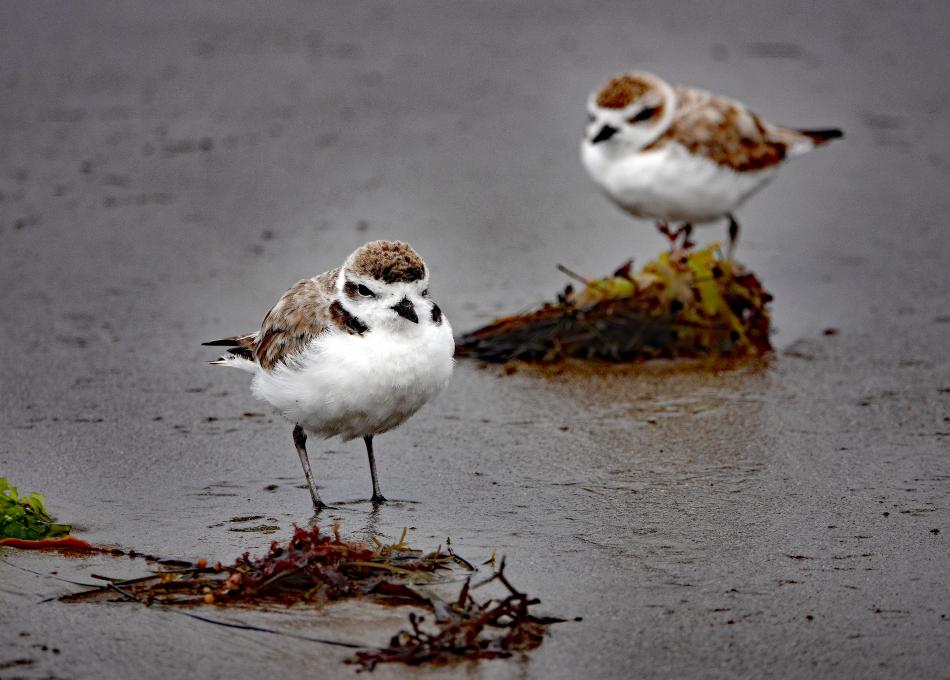 The rear bird is slightly out of focus due to narrow range of focus (F4).
The rear bird is slightly out of focus due to narrow range of focus (F4).


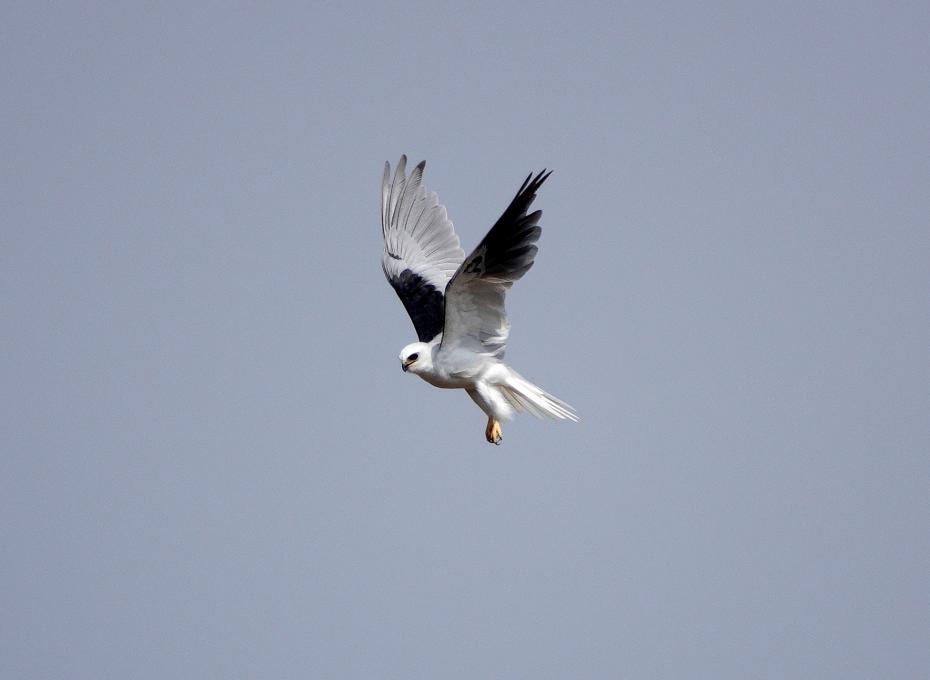
 Obviously I had to crop a good amount. I was shooting F4, 1/1250 at ISO 100. In burst mode this camera gets as many as 20 shots per second. What I noticed was that in every other photo the bird's wings were up and the other they were down. In the 3rd one the bird was flying directly toward me. The advantage of photographing a kite is that once you have the camera on the bird it pretty much stays in the same location in the sky.
Obviously I had to crop a good amount. I was shooting F4, 1/1250 at ISO 100. In burst mode this camera gets as many as 20 shots per second. What I noticed was that in every other photo the bird's wings were up and the other they were down. In the 3rd one the bird was flying directly toward me. The advantage of photographing a kite is that once you have the camera on the bird it pretty much stays in the same location in the sky. 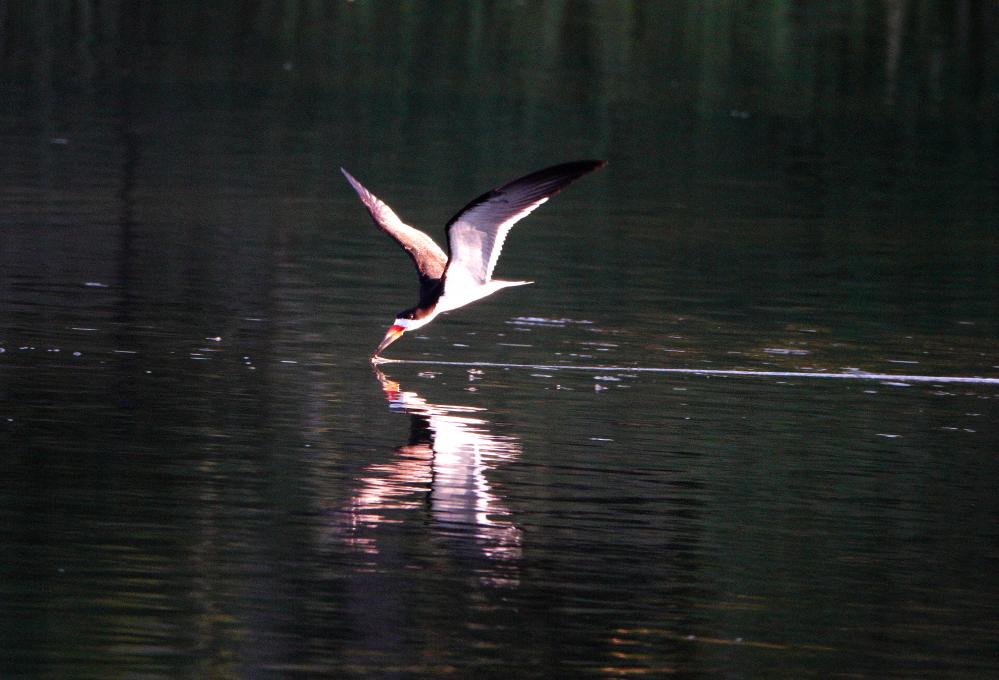 Up close I noticed a couple of Black Necked Stilts probing in the water much closer to me. I especially liked the color of the water. Unfortunately I did not capture the full reflection as I was zoomed in too far.
Up close I noticed a couple of Black Necked Stilts probing in the water much closer to me. I especially liked the color of the water. Unfortunately I did not capture the full reflection as I was zoomed in too far.
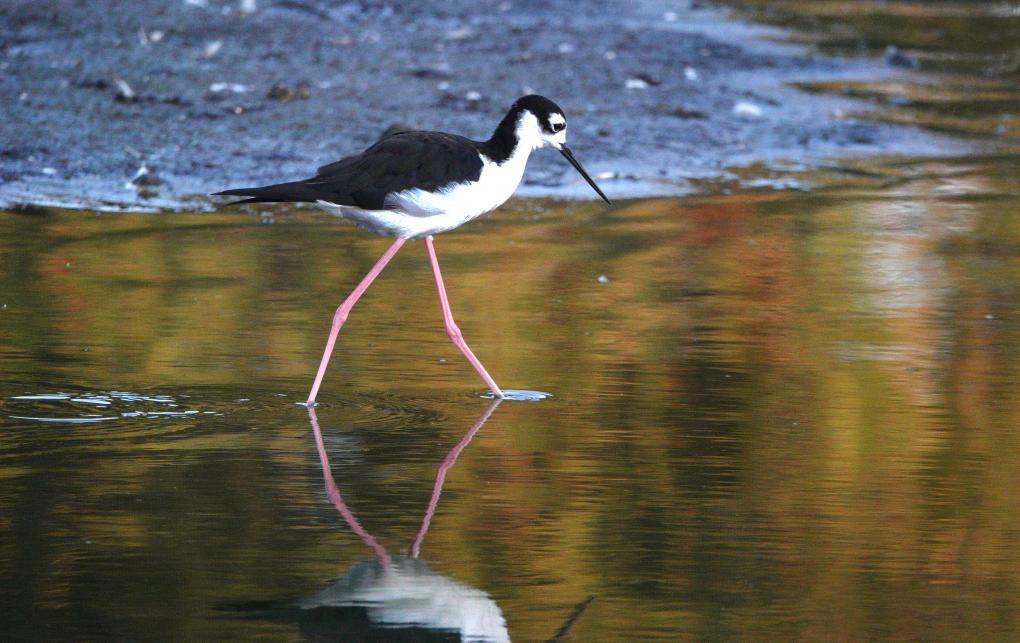 The Snowy Egrets became quite boisterous. I have always been challenged when multiple birds are interacting, but I did capture these two and after correcting for burnt our white, and some cropping in Photoshop I got this playful image.
The Snowy Egrets became quite boisterous. I have always been challenged when multiple birds are interacting, but I did capture these two and after correcting for burnt our white, and some cropping in Photoshop I got this playful image.
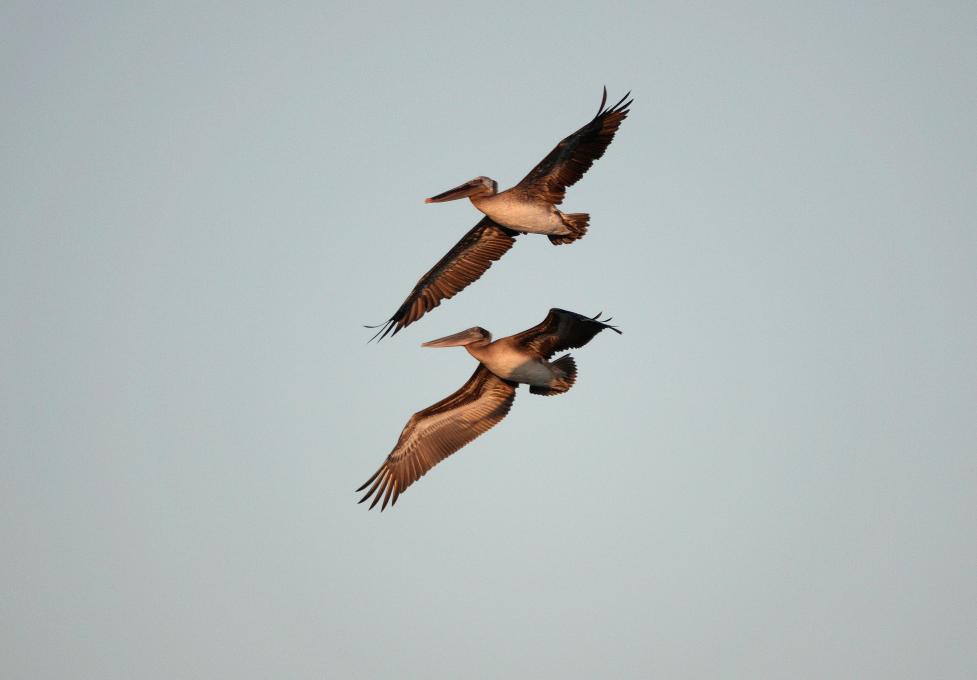
 The Brown Pelican (Pelicanus occidentalis) is a common species today along all our coast but it was on the Endangered Species list from 1970 to 2009 and became extinct in some states. The cause was the use of the now banned pesticide DDT which caused pelican eggs to become so thin they would fracture before the embryo was fully developed. There has been an enormous conservation effort to restore this magnificent species, especially so in Santa Barbara where some of my birding colleagues have done regular brown pelican counts. They are very sociable birds both congregating and flying together often in large groups. I know that there is a breeding colony on Anacapa Island off the southern California coast. It is an enormous bird and because of its size it is easier to photograph in flight than most other smaller birds. The birds I've been seeing lately along with the Black Skimmers are juveniles, the adult being mostly gray and white. It is fun to watch them when they dive head first into the ocean to capture fish.
The Brown Pelican (Pelicanus occidentalis) is a common species today along all our coast but it was on the Endangered Species list from 1970 to 2009 and became extinct in some states. The cause was the use of the now banned pesticide DDT which caused pelican eggs to become so thin they would fracture before the embryo was fully developed. There has been an enormous conservation effort to restore this magnificent species, especially so in Santa Barbara where some of my birding colleagues have done regular brown pelican counts. They are very sociable birds both congregating and flying together often in large groups. I know that there is a breeding colony on Anacapa Island off the southern California coast. It is an enormous bird and because of its size it is easier to photograph in flight than most other smaller birds. The birds I've been seeing lately along with the Black Skimmers are juveniles, the adult being mostly gray and white. It is fun to watch them when they dive head first into the ocean to capture fish. 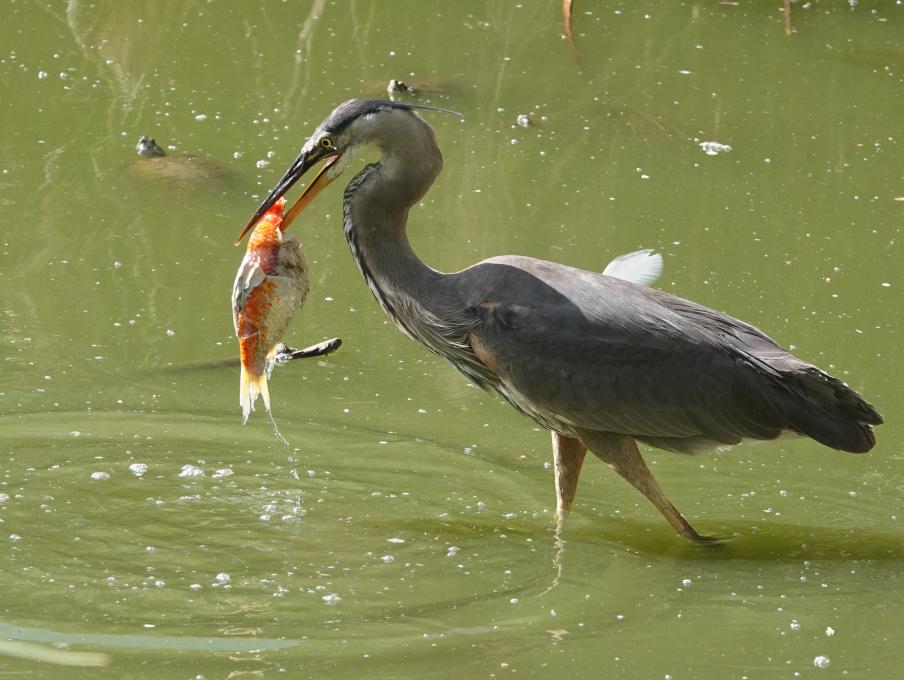 I live a block from Alice Keck Park and walk my dog there often in the mornings. One day I noticed a juvenile Great Blue Heron in the pond. I walked home and got my camera, then waited for about an hour while watching this bird's movements. Suddenly he spotted and caught a large fish and held it in his bill. The fish was obviously too large for him to swallow, so he had to drop it. I shot multiple frames.
I live a block from Alice Keck Park and walk my dog there often in the mornings. One day I noticed a juvenile Great Blue Heron in the pond. I walked home and got my camera, then waited for about an hour while watching this bird's movements. Suddenly he spotted and caught a large fish and held it in his bill. The fish was obviously too large for him to swallow, so he had to drop it. I shot multiple frames.
 I often bird in the evenings at the Andree Clark Bird Refuge in Santa Barbara. I was seated at the third viewing platform when a young Black Crowned Night Heron flew in and landed on the bench not more than 15 feet away from me. He was quite comfortable sitting there and watching me for several minutes. It was a wonderful experience! These birds are breeding in this area as I have seen several juveniles there as well.
Dika Golovatchoff
I often bird in the evenings at the Andree Clark Bird Refuge in Santa Barbara. I was seated at the third viewing platform when a young Black Crowned Night Heron flew in and landed on the bench not more than 15 feet away from me. He was quite comfortable sitting there and watching me for several minutes. It was a wonderful experience! These birds are breeding in this area as I have seen several juveniles there as well.
Dika Golovatchoff  I have continued to photograph Black Skimmers at the beach in Santa Barbara, CA, this time with my Sony RX10 Mark 4. I shot in manual mode with auto ISO. F4 at 1/1000. I was shooting in burst mode at about 20 per second. Tracking these birds is really hard as they often fly out of the frame and if I'm zoomed in too far a wing tip will get chopped off. I am trying to allow for room for the bird to fly into as Melissa stressed. My criteria in selecting an image are: sharpness of bird, attractive wing position, catch-light visible on the eye, and in this case mandibles shown in skimming position.
There is a period of about 1/2 hour where the light is good before it fades. Many of these birds were skimming at once over a narrow channel parallel to the ocean. This depends on the tide. There were shorebirds in the background on the beach, in this photo 3 Whimbrels. I liked the warm light on the sand and the shadow behind the bird. I shot in jpeg this time and the only small edit I made was to bring out a bit more detail in the skimmer's lower wing. Just to give an idea I came home with about 200 images. I project on the TV first direct from the camera and do successful delete until I'm left with a manageable group. I used the newest version of Adobe Photoshop which is part of Elements, which also includes Premiere since I'll try making a composite video. I learn a lot from each shooting session. Sorry, I forgot to include my name: Dika Golovatchoff digolov@gmail.com
I have continued to photograph Black Skimmers at the beach in Santa Barbara, CA, this time with my Sony RX10 Mark 4. I shot in manual mode with auto ISO. F4 at 1/1000. I was shooting in burst mode at about 20 per second. Tracking these birds is really hard as they often fly out of the frame and if I'm zoomed in too far a wing tip will get chopped off. I am trying to allow for room for the bird to fly into as Melissa stressed. My criteria in selecting an image are: sharpness of bird, attractive wing position, catch-light visible on the eye, and in this case mandibles shown in skimming position.
There is a period of about 1/2 hour where the light is good before it fades. Many of these birds were skimming at once over a narrow channel parallel to the ocean. This depends on the tide. There were shorebirds in the background on the beach, in this photo 3 Whimbrels. I liked the warm light on the sand and the shadow behind the bird. I shot in jpeg this time and the only small edit I made was to bring out a bit more detail in the skimmer's lower wing. Just to give an idea I came home with about 200 images. I project on the TV first direct from the camera and do successful delete until I'm left with a manageable group. I used the newest version of Adobe Photoshop which is part of Elements, which also includes Premiere since I'll try making a composite video. I learn a lot from each shooting session. Sorry, I forgot to include my name: Dika Golovatchoff digolov@gmail.com 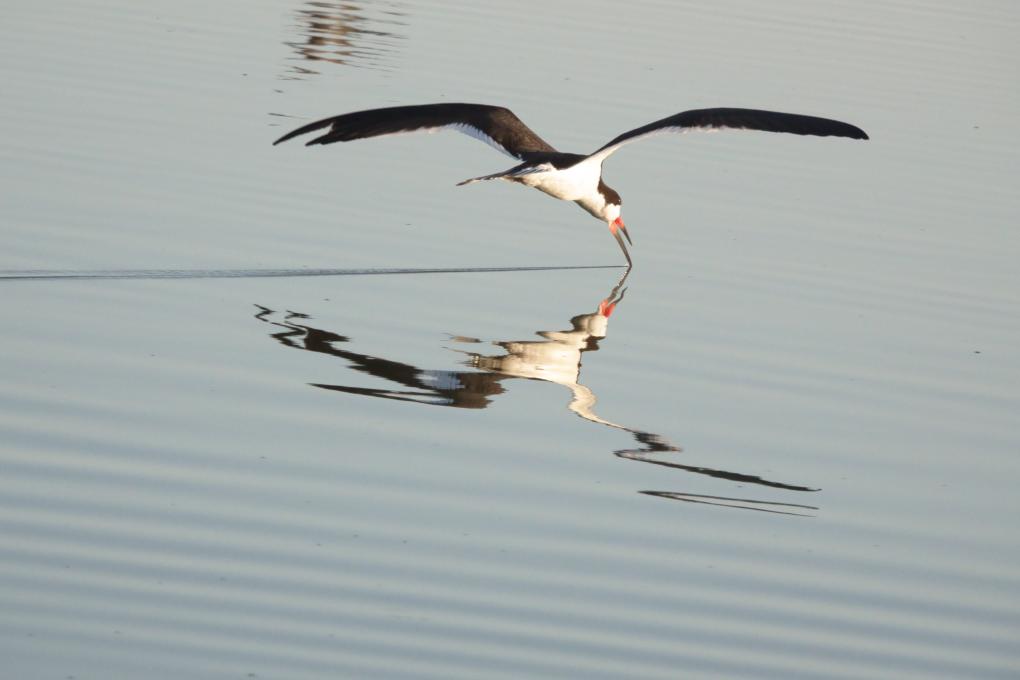 Practice, Practice, and practice - Melissa is right. I wanted to capture one or more Black Skimmers flying - but more specifically while skimming for fish. I went 4 evenings to the same location, selecting different vantage points for observing. The best time was between 7 and 8 PM as the sun was going down. The light changed a lot during the one hour I was there, and in the end it was quite dark.
The first two nights I used my Canon 7D Mark 11 with 100-300 mm lens and 1.4 extender. Second 2 night I used my Sony RX10 Mark IV zooming its lens between about 300-600 mm depending upon where the bird was in its flight. This is very challenging - as multiple birds fly very quickly and my goal was to catch one on a smooth water surface and showing clear reflection of bird. I used manual mode all the time which made things more challenging for me as many exposures turned out to be off and I found myself using exposure compensation quite a bit. My Sony does not permit ISO auto in burst mode, so all my 3 values were pre-selected.
This is one of my most pleasing shots as it also shows the trial left in the water by the skim. My next goal would be to be more right on with exposures. I was shooing RAW and used the digital editing software provided by the camera makers. This was my first experience using Imaging Edge from Sony. (I do not have Lightroom).
I have more experience with the Canon (having shot skimmers before with it) than the Sony. Its a challenge, and I'll keep trying. I find Black Skimmers a very interesting species and learned that they do not rely on their eyes for finding prey, in fact their eyes are slit vertically.
Practice, Practice, and practice - Melissa is right. I wanted to capture one or more Black Skimmers flying - but more specifically while skimming for fish. I went 4 evenings to the same location, selecting different vantage points for observing. The best time was between 7 and 8 PM as the sun was going down. The light changed a lot during the one hour I was there, and in the end it was quite dark.
The first two nights I used my Canon 7D Mark 11 with 100-300 mm lens and 1.4 extender. Second 2 night I used my Sony RX10 Mark IV zooming its lens between about 300-600 mm depending upon where the bird was in its flight. This is very challenging - as multiple birds fly very quickly and my goal was to catch one on a smooth water surface and showing clear reflection of bird. I used manual mode all the time which made things more challenging for me as many exposures turned out to be off and I found myself using exposure compensation quite a bit. My Sony does not permit ISO auto in burst mode, so all my 3 values were pre-selected.
This is one of my most pleasing shots as it also shows the trial left in the water by the skim. My next goal would be to be more right on with exposures. I was shooing RAW and used the digital editing software provided by the camera makers. This was my first experience using Imaging Edge from Sony. (I do not have Lightroom).
I have more experience with the Canon (having shot skimmers before with it) than the Sony. Its a challenge, and I'll keep trying. I find Black Skimmers a very interesting species and learned that they do not rely on their eyes for finding prey, in fact their eyes are slit vertically.